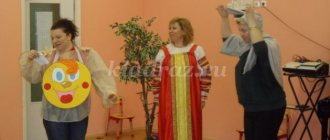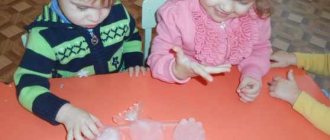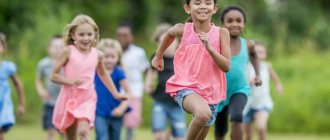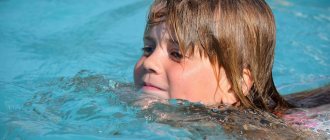MAGAZINE Preschooler.RF
MKU "Education Department" Administration of the city of Apatity municipal budgetary preschool educational institution general developmental kindergarten No. 50 Organization of events aimed at strengthening the health of the child and his physical development Project “System of physical education and health activities in the younger group for a week in the summer” Prepared by early childhood group teacher Lyubov Sergeevna Novikova 2014, Apatity Introduction The formulation of the problem of this topic is manifested in the organization of physical education and health work with children. This problem is especially acute in an educational institution, where it should produce tangible results. According to the results of the survey, recently there has been a decrease in indicators of the level of children’s health and their physical development. Insufficient motor activity - hypokinesia - is observed in very young children. Of course, first of all, the muscular system suffers from hypokinesia, muscle tone decreases. Thus, it contributes to disruption of posture, blood circulation, cardiovascular system, respiratory function, and central nervous system. In this regard, health culture is a component of the overall cultural system. This is due to the fact that evolution is possible only in a healthy society, and speaks of the inevitability of the formation of a culture of health - individual and populationGoal: To provide favorable conditions for protecting the lives and strengthening the health of children. Objectives: • Wellness: to preserve and strengthen the physical and mental health of children. • Developmental: develop the need for physical activity and physical improvement. • Educational: to form motor skills, instill initial ideas about a healthy lifestyle. • Educational: develop the need for daily physical exercise, cultivate cultural and hygienic skills. Methods: Theoretical Analysis of scientific and methodological literature Empirical Development of a system of physical education and health work with young children for a week in the summer Methods used in physical education classes • Regulated exercises • Precise load regulation • Game-based • Visual Practical methods • Organization of practical work with children • Formation sustainable interest, positive attitude of preschoolers to physical education classes • Development of basic physical qualities • Nurturing strong-willed qualities, attention, self-control, responsibility Visual methods Consultations for parents.
Expected result: • Improve the health of preschool children • Increase the level of physical activity • Provide favorable conditions for preserving and strengthening the health of children A system of physical education and health work in the younger group for a week in the summer. Working with parents: Appendix No. 13 1. Consultations “The daily routine of a preschooler on weekends and holidays.” “Movement is the basis of health” 2. Participation in the creation of beneficial conditions for children’s physical activity, in joint activities, holidays, and leisure activities. Evaluation of results In order to improve the health of preschool children, the physical education system in a children's educational institution should include various forms of physical exercise that increase the level of physical activity of children (morning exercises, physical education classes, games, walking exercises, etc.). Physical education and health work with preschool children is planned in accordance with the principles of consistency, systematicity, comprehensiveness of the use of natural forces of nature and hygienic factors, as well as health-improving methods. The effectiveness of health-improving work with young children will depend on the use of health-improving means and the level of teachers’ proficiency in organizing and conducting traditional methods of health-improvement.
Appendix No. 1 MORNING GYMNASTICS
“My geese” Educator. Today you guys and I will be geese. Geese, geese! Children. Ga-ga-ga. Educator. Well, fly here! The guys gather around the teacher. Educator. Geese are walking on the lawn. (Walking in a flock (15 seconds).) The geese raised their wings up. (Walk behind the teacher, hands up (15 seconds).) Geese enjoy the sun. (Running in all directions (15 seconds).) Formation in all directions. Exercise “Geese woke up” Starting position: standing, arms down. Raise your arms up to your sides and say: “Ha-ha!” Return to starting position. Repeat 5 times. The pace is slow. Exercise “Geese hiss” Starting position: standing, hands behind your back. Lean forward, move your arms back, say: “Shhh.” Return to starting position. Repeat 3 times. The pace is slow. Exercise “Geese Hid” Starting position: standing, hands down. Sit down, put your hands on your head. Return to starting position. Repeat 4 times. The pace is moderate. Demonstration and explanation by the teacher. Exercise “Geese are happy” Starting position: standing. Bouncing in place. Repeat 2 times for 10 seconds. Final part Educator. Geese, geese! Children. Ha-ha-ha! Educator. Do you want to eat? Children. Yes Yes Yes! Educator. Well, fly home. Slowly run after the teacher in a “flock” (30 seconds). Walk slowly behind the teacher (30 seconds). Breathing exercise “Blowing on wings” Instructions: exhale longer than inhale. The children return to the group.
Appendix No. 2 ARICULATIVE GYMNASTICS Cowardly chick Open and close your mouth wide, so that the corners of your lips stretch out. The jaw drops approximately the width of two fingers. The “chick” tongue sits in the nest and does not protrude. The exercise is performed ri. We open our mouth wide, so that the corners of our lips extend, then close it. We perform 6-8 times.
Appendix No. 3 MKU "Education Department" Administration of the city of Apatity municipal budgetary preschool educational institution general developmental kindergarten No. 50
Summary of educational activities for musical activities in a younger age group
Prepared by teacher MBDOU kindergarten 50 Novikova Lyubov Sergeevna
Apatity, 2014 Synopsis of the musical NOD in the junior group “Who said “Meow” Program content: Develop the creative and musical abilities of children. Develop pitch perception of hearing. Learn to sing with different intonations. Preliminary work: Learning Popatenko T.’s song “Bobik”. Learning the nursery rhyme “Cockerel”. Equipment: In the group you need to arrange three small areas: a corner with a mattress on which the puppy sleeps; a small fence on which a rooster sits; a bush in which a mouse and a cat are hidden. GCD move: Chairs are placed one after another. Teacher Hello, guys! Today we will take you on a fun journey. Want to? Then we will now turn our chairs into steam locomotive trailers and go. Get on quickly, the train is leaving for a fairy tale. Go! Children sit on chairs and perform rotational movements with their arms to cheerful music. Educator: Look, we came to visit a dog whose name is Bobik. Let's say hello to him. Children greet with different intonations, which are set by an adult. — And you and I know a song about Bobik. Let's sing it to him. Children perform the song “Bobik” Popatenko T. — Once upon a time, an amazing story happened to Bobik. Let's listen to her too. After dinner, our puppy lay down in the corner to sleep. He stuck his tail under the sofa and hid his wet nose in his paws. Guys, Bobik wants us to sing him a lullaby. Let's gently and quietly sing him a lullaby. Children perform swaying movements with their hands and sing “Bayu-Bayu” to a tune of 3-4 sounds. Our puppy fell asleep. And at this time... Suddenly a “meow-meow” sounded very loudly in my ear. Bobik looked under the table and into the cupboard - there was no one in the apartment. The puppy ran into the yard... - Guys, let’s run with the puppy into the street. Children run around the hall to the music on their toes and run up to the fence on which the Cockerel is sitting. - Guys, look who Bobik met on the street. Who is this? That's right, Golden Comb Cockerel. And you and I know a song about a cockerel. Let's sing it. Children perform the nursery rhyme "Cockerel". Bobik asks Cockerel: “Did you meow or not? Give me an answer soon!” And the Rooster said to the Puppy: “I’m singing...” - Guys, how does the cockerel sing? Let's all sing loudly together: ku-ka-re-ku! Children repeat. And now it's quiet. Children change their intonation. - Well done! And our Puppy moved on. And we will go with him. Children walk around the hall to the music and approach the bushes. - And again our Bobik heard someone say “meow!” The Puppy looked and saw that a little Mouse was hiding in the bushes. The teacher takes out the Mouse. - Guys, how does the mouse squeak? That's right: pee-pee-pee. But our Mouse does not live alone, but with her mother. How does the mother mouse squeak? The game “High-Low Sounds” is played (the music director plays one sound in different registers, and the children must say who the voice belongs to) - Guys, if a Mouse lives here, then he probably definitely lives nearby... The teacher takes out the Cat. - Oh, who is this? That's right, Cat. So that's who said "meow". Now Bobik knows who woke him up. Guys, let's play with the cat. We will turn into little mice. While the cat is sleeping, the mice walk quietly on their toes. And when the cat wakes up, the mice run into their holes. The game “Cat and Mice” is played. Musical accompaniment at the discretion of the music director. - That's how fun we played. Now, let's dance with Bobik and the cat. Children perform “Little Dance” (music by N. Aleksandrova) - This is an interesting story that happened to our Bobik. The puppy went back to sleep, and the cat ran outside for a walk. It's time for you and me to return to the group. Get into our trailers and we'll go back to kindergarten. Children sit on chairs and perform rotational movements with their arms to the music.
| Next > |
“System of comprehensive measures for the health of young children”
- December 4, 2019
International and All-Russian competitions
All-Russian competition of pedagogical excellence “Methodological piggy bank of a kindergarten teacher”
“System of comprehensive measures for the health of young children”
author of the article: Mezhidova Kristina Aleksandrovna
teacher, MBDOU No. 6 “Firefly”, Gadzhievo city
Active muscular activity is a prerequisite for the normal development and formation of a growing child’s body, therefore, in order to strengthen the health of children and prevent diseases, we first of all began to increase the level of physical activity, as well as to include and systematically carry out hardening activities. Two factors: active motor activity, consisting of outdoor games and special preventive exercises, plus traditional and non-traditional hardening procedures, in our opinion, play a key role in the health improvement of preschool children in preschool settings.
Methods for promoting the health of young children
1. First of all, starting from the first junior group, we began to include in morning and invigorating gymnastics exercises and games to strengthen the musculoskeletal system: “Mice in the Pantry”, “Little Frog”, “Squirrel”, “Roll the Hoop”, “ Walk Sideways", "The Kite and the Hen"; exercises and games to strengthen the arch of the foot with and without objects: “Duck Walking”, “Step over your hands”, “Camel”, “Horse”, “Raise the lace with your feet”. During the day, the density of children’s physical activity was increased through various outdoor games. Depending on the task, we organized: games with running and jumping; games with crawling; sedentary games; throwing and catching games; games for orientation in space.
2. Introduced the children to relaxation exercises.
Relaxation technique according to E. Jacobson
Do not forget that the physical health of children is inseparable from their emotional state. Negative states—fear, longing for parents, anxiety, despondency—cause enormous harm to a child’s health. Therefore, we turned to a technique that helps a child overcome stress - relaxation according to E. Jacobson. This method is based on alternating two states – neuromuscular tension and relaxation. Gymnastics is suitable for children with increased anxiety, prone to worry and worry.
Recommendations for conducting exercises.
The procedure for conducting such games involves performing monotonous and monotonous movements to relax and tense certain muscle groups; special attention should be paid to breathing: muscle tension exercises are done while taking a deep nasal inhalation, relaxation exercises while exhaling through the mouth. When introducing a child to Jacobson gymnastics, it is necessary to explain how to tense and relax various muscle groups, and pay attention to whether the child performs the exercise correctly. These games can be played individually with one or two children or with a subgroup, they can be included in morning and invigorating exercises, and carried out as physical exercise before and during classes. Games based on neuromuscular relaxation are played to the accompaniment of calm, quiet music.
Goal: strengthen the muscular “corset” of the spine, relieve psycho-emotional tension.
Procedure. In a lying position (on his back), the child raises his hands behind his head and stretches out as much as possible. Then, he lifts the upper half of his body and leans forward, pulling his legs towards his torso. In this way, the child groups himself (curls up like a hedgehog) and clasps his legs with his arms. Repeat 2-6 times. Lie down and relax between each repetition.
3. We performed breathing exercises for the purpose of rehabilitation for diseases of the bronchi and lungs.
Breathing according to the method of A. Strelnikova
Breathing affects all physiological processes occurring in the body: physical and mental state, mental activity.
A.N. Strelnikova proposed a method for treating diseases associated with the respiratory system. A. Strelnikova’s technique consists of using breathing exercises: when the chest contracts during breathing movements, the child takes an active breath; when moving, when the chest expands, passive exhalation. We use this technique to prevent diseases of the respiratory system. We carried out exercises according to the method every day and included them in invigorating and morning exercises.
Exercise “Owl” (respiratory gymnastics)
The owl wakes up
1. I. p. - sitting. Calm breathing.
The wings wake up
2.I.p. - sitting. Raise your arms to the sides - inhale, lower - exhale.
3. I.p. - sitting. Spread your arms to the sides, turn your torso to the right - inhale, return to the i.p. - exhale. Same thing in the other direction
Paws wake up
4. I. p. - the same. Flexion and extension of the feet. Breathing is voluntary.
5.I. p. - sitting, legs together. Spread your arms to the sides at shoulder level - inhale, pull your legs to your chest - exhale.
6. I. p. - sitting, hands on the belt. Spread your arms to the sides at shoulder level - inhale, bend your torso forward, reach your right foot with your hands - exhale. Return to i. n. Repeat similar movements with the other leg. sanitized_by_modx& #39
The owl flew
7. Run in a circle, swing your arms.
All movements are repeated 6-8 times.
4. Included forms of acute respiratory infections prevention in the daily regimen:
— compliance with the ventilation regime. Every hour and a half in the absence of children.
- quartzing of group rooms and bedrooms 3 times a day.
— maintaining the air temperature in the playroom within 22 C.
— optimal motor mode (4 hours a day).
— fortification of third courses. Consumption of onions and garlic in the autumn-winter period
- organization of walks 2 times a day. In the morning and in the evening. Carrying out outdoor games during a morning walk.
5. We gradually began to introduce hardening procedures.
Hardening is one of the generally accepted traditional methods of preventing acute respiratory infections.
Hypothermia plays a significant role in acute respiratory diseases. In unhardened children, cooling of the feet causes a reaction in the mucous membranes of the upper respiratory tract: the integumentary epithelium of the respiratory tract cannot cope with its protective function. Therefore, we began to use hardening with contrasting temperature effects: air baths and water procedures. It is these methods that contribute to the development and improvement of the physical thermoregulation system.
Contrast air hardening
By the end of the day's sleep in the playroom, the temperature dropped to
+ 18°C. At 15 o'clock, the children woke up to the sounds of music and performed the following physical exercises for 3 minutes: they pulled their legs, bent at the knee, to their chest and straightened them; performed cross and parallel movements of arms and legs; performed the “bicycle” exercise; while lying on the stomach, the chest and legs were simultaneously raised; Breathing exercises were carried out according to the method of A. Strelnikova, sitting on the beds, feet touching the floor. Afterwards, the children got out of bed and did the following exercises for 2 minutes: walking in place, jumping, neuromuscular relaxation exercises, then moved on to the “cold” play area.
The temperature difference in the two rooms was 3°C. The temperature in the playroom was reduced by ventilation. Staying in the bedroom differed from being in the “cold” playroom with a calm pace of movement so that the children did not overheat while performing physical exercises. The following exercises were used in the “cold” game: running, active outdoor games. The number of runs from one room to another should be at least three.
Walking barefoot
Walking barefoot is an effective non-traditional hardening method aimed at activating immune processes and strengthening the arches of the feet.
Starting from the first junior group, we conducted outdoor games: the children took off their sandals and played for 3-4 minutes in socks; a week later we played outdoor games barefoot. We gradually increased the time of walking barefoot and eventually brought it up to 15 minutes a day.
Contrast water hardening of feet
Water procedures, especially water foot baths, are of great importance in developing the child’s body’s resistance to changing environmental temperature conditions. We started carrying out water procedures from the second youngest group. During invigorating gymnastics, after the main exercises, the children alternately lowered their legs (the lower third of the lower leg) into a small basin of water at a temperature of +36°C, then lowered their legs into a basin of water at 30-31°C. Every week the water temperature in the second basin was lowered and brought to +18°C. First, the legs were immersed in warm water, then immediately in cold water for 10 seconds. Gradually, the time spent in cold water increased to 15-20 seconds.
When carrying out hardening procedures, children should not be involved in the following cases:
- if five days have not passed since the vaccination performed as part of preventive measures, or recovery from illness.
- less than two weeks have passed since the exacerbation of a chronic disease.
— the evening of the previous day the child complained of feeling unwell.
— the child developed a panic fear before hardening sessions.
6. Working with parents.
At the beginning of the year, at the first parent meeting, we introduced parents to methods of improving children's health and to planned events for the year. We conducted a survey to find out what parents know about ways to maintain the health of their children. Based on the results of the survey, leaflets were prepared: “Psychological safety of the child”, “Methods of preserving the health of the child”; consultations: “Neuromuscular relaxation exercises”; “Breathing exercises: prevention of diseases of the respiratory system”, “Active games to strengthen the musculoskeletal system”, “Games and exercises to prevent flat feet”.
Hardening procedures were introduced gradually and were designed for certain periods of time, all information was reflected in booklets: “Hardening, first stage. (September – November)”; “Hardening, second stage (December-February)”; “Hardening, third stage (March-April).”
In addition to consulting and discussing main topics, we met with parents and children in joint physical education classes: “Playing and Relaxing” (introducing parents to neuromuscular relaxation exercises); “Breathing exercises and outdoor games” (introducing parents to A. Strelnikova’s breathing exercises complex).




